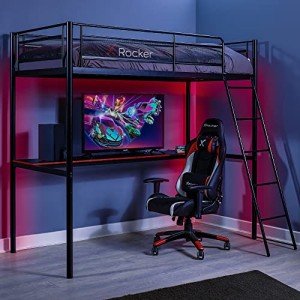
Toddler Bunk Beds
Overview
-
Sectors Accounting / Finance
Company Description
The 10 Most Scariest Things About UK Bunk Beds
Understanding UK Bunk Beds: A Comprehensive Guide
Bunk beds have actually become a popular option for many homes across the United Kingdom. They offer an effective solution for saving space, accommodating several sleepers, and including a component of fun to a kid’s space. With different designs, products, and safety functions available, choosing the right bunk bed can be intimidating. This article intends to provide an extensive look into uk bunk beds (carrieresecurite.fr), covering their types, advantages, safety standards, and purchasing pointers.
The Types of Bunk Beds
When it concerns bunk beds, the options are essentially unlimited. The primary categories include:

1. Standard Bunk Beds
These are the classic design, featuring two beds stacked one on top of the other. Basic bunk beds are best for brother or sisters sharing a room or pajama parties.
2. Loft Beds
Loft beds are raised beds without a lower bunk. This design uses ample space underneath for a study location, extra storage, or play space for children.
3. L-Shaped Bunk Beds
These beds have an L-shape design, permitting them to suit corners or odd areas in a space. They are often perfect for larger spaces and use versatility in sleeping plans.
4. Triple Bunk Beds
Designed for bigger families, triple bunk beds accommodate three sleeping areas. These beds offer vertical sleeping plans and can be an outstanding choice for taking full advantage of room capability.
5. Futon Bunk Beds
These flexible beds combine a basic upper bunk with a futon or couch listed below. This style can be utilized for sleeping or seating, making it a multifunctional option for smaller sized areas.
6. Bunk Beds with Storage
Some contemporary bunk beds come geared up with drawers or shelving, supplying extra storage space for clothing, toys, or books. This feature is especially beneficial in rooms that require organized storage services.
Advantages of Bunk Beds
Bunk beds provide various advantages, making them a desirable choice for lots of families:
-
Space-Saving: Bunk beds use vertical space, allowing for more open floor area in smaller rooms.
-
Price: Sharing a space and purchasing one bunk bed can be more cost-effective than purchasing separate beds for numerous kids.
-
Enjoyable Factor: Bunk beds offer a sense of adventure and enjoyment, especially for kids, making bedtime more enjoyable.
-
Versatile Layouts: With various designs offered, bunk beds can fit any room layout, ensuring style and performance.
-
Storage Options: Many designs integrate additional storage services, helping to keep rooms neat.
| Advantages of Bunk Beds | Description |
|---|---|
| Space-Saving | Uses vertical space to release up floor area. |
| Cost | More cost-efficient for households with several children. |
| Fun Factor | Adds excitement to bedtime and promotes imaginative play. |
| Versatile Layouts | Combinations can fit different room configurations. |
| Storage Options | Integrated drawers and shelves assist keep items arranged. |
Safety Standards
When picking bunk beds, safety needs to be a top priority, especially for children. The UK has developed regulations to guarantee that bunk beds meet specific safety standards. For example:
-
Guardrails: Beds must have guardrails on both sides of the top bunk to avoid accidental falls.
-
Mattress Size: Beds need to work with a correct bed mattress size to ensure safe use. The bed mattress should not exceed the top of the guardrails.
-
Tough Construction: Bunk beds ought to be made from long lasting products to withstand routine use, making sure stability and durability.
-
Weight Limit: Every bunk bed has a weight limitation which must be complied with for safety reasons.
-
Assembly Instructions: Proper assembly is essential; follow the producer’s guidelines carefully to ensure structural stability.
Acquiring Tips
When set to buy a bunk bed, consider the following points:
-
Room Size: Measure the room measurements to make sure the chosen bed fits easily.
-
Height Consideration: Ensure there suffices room above the leading bunk to avoid bumps on the ceiling.
-
Material Choice: Look for sturdy materials with a quality finish. Wood and metal are popular choices, with each providing different aesthetics and durability.
-
Safety Features: Verify that the bed fulfills security requirements and has adequate guardrails and a sturdy ladder.
-
Style Compatibility: Select a style that complements the existing decoration of the space.
-
Budget: Set a spending plan before exploring your alternatives, as bunk beds can span a large cost range.
Regularly Asked Questions (FAQs)
1. What age is proper for a leading bunk?
Normally, children aged 6 and older can sleep on the leading bunk, however always examine specific manufacturer guidelines for age suggestions.
2. How do I preserve my bunk bed?
Frequently inspect for any loose screws or parts, tidy the bed occasionally, and ensure it stays steady.
3. Can bunk beds accommodate adults?
While some bunk beds are created for heavier weights, the majority are mainly planned for kids. Inspect the weight restricts if considering adult use.
4. Are bunk beds easy to assemble?
Many bunk beds feature in-depth assembly instructions and all essential tools. However, some styles might need expert assembly.
5. Can I utilize a thicker mattress on a bunk bed?
It is vital to follow the manufacturer’s standards concerning bed mattress thickness to guarantee safety and compliance with the guardrails.
Bunk beds are a versatile and useful alternative for families looking to make the most of space and produce an enjoyable sleeping environment for their kids. With a myriad of designs offered, it’s important to consider the specific requirements of the home while focusing on safety and comfort. By comprehending the different types, advantages, and important factors to consider surrounding bunk beds, moms and dads can make informed decisions that will enhance their children’s living spaces.


